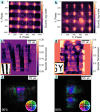Single-shot ptychography at a soft X-ray free-electron laser
- PMID: 36002577
- PMCID: PMC9402553
- DOI: 10.1038/s41598-022-18605-x
Single-shot ptychography at a soft X-ray free-electron laser
Abstract
In this work, single-shot ptychography was adapted to the XUV range and, as a proof of concept, performed at the free-electron laser FLASH at DESY to obtain a high-resolution reconstruction of a test sample. Ptychography is a coherent diffraction imaging technique capable of imaging extended samples with diffraction-limited resolution. However, its scanning nature makes ptychography time-consuming and also prevents its application for mapping of dynamical processes. Single-shot ptychography can be realized by collecting the diffraction patterns of multiple overlapping beams in one shot and, in recent years, several concepts based on two con-focal lenses were employed in the visible regime. Unfortunately, this approach cannot be extended straightforwardly to X-ray wavelengths due to the use of refractive optics. Here, a novel single-shot ptychography setup utilizes a combination of X-ray focusing optics with a two-dimensional beam-splitting diffraction grating. It facilitates single-shot imaging of extended samples at X-ray wavelengths.
© 2022. The Author(s).
Conflict of interest statement
The authors declare no competing interests.
Figures





References
-
- Guizar-Sicairos M, Thibault P. Ptychography: A solution to the phase problem. Phys. Today. 2021;74:42–48. doi: 10.1063/PT.3.4835. - DOI
Grants and funding
LinkOut - more resources
Full Text Sources

